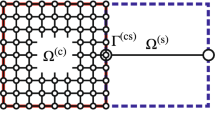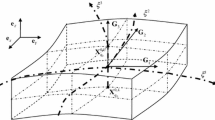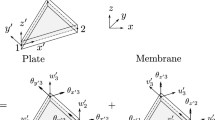Abstract
In this paper we present a low-order solid-shell element formulation—having only displacement degrees of freedom (DOFs), i.e., without rotational DOFs. The element has an additional middle node, that allows efficient and accurate analyses of shell structures using elements at extremely high aspect ratio. The formulation is based on the Hu–Washizu variational principle leading to a novel enhancing strain and stress tensor that renders the computation particularly efficient, with improved in-plane and out-of-plane bending behavior (Poisson thickness locking). The middle-node is endowed with only one degree of freedom, in the thickness direction, allowing the assumption of a quadratic interpolation of the transverse displacement. Unlike solid-shell finite elements reported previously in the literature and formulated under the hypothesis of plane stress or with enhanced assumed strain parameter, the new solid-shell element here mentioned uses a complete three-dimensional constitutive law and gives an enhanced pinching stress, thanks to the middle-node. Moreover, to handle the various locking problems that usually arise on solid-shell formulation, the reduced integration technique is used as well as the assumed shear strain method. Finally to assess the effectiveness and performance of this new formulation, a set of popular benchmark problems, involving geometric non-linear analysis as well as elastic-plastic behavior has been investigated.



















Similar content being viewed by others
References
Parisch H (1995) A continuum-based shell theory for non-linear applications. Int J Numer Meth Eng 38(11):1855–1883
Wriggers P, Eberlein R, Reese S (1996) A comparison of three-dimensional continuum and shell elements for finite plasticity. Int J Solids Struct 33(20–22):3309–3326
Hauptmann R, Schweizerhof K (1998) A systematic development of ‘solid-shell’element formulations for linear and non-linear analyses employing only displacement degrees of freedom. Int J Numer Meth Eng 42(1):49–69
Hauptmann R, Schweizerhof K, Doll S (2000) Extension of the ‘solid-shell’concept for application to large elastic and large elastoplastic deformations. Int J Numer Meth Eng 49(9):1121–1141
Sze KY, Yao LQ (2000) A hybrid stress ans solid-shell element and its generalization for smart structure modelling. part i-solid-shell element formulation. Int J Numer Meth Eng 48(4):545–564
Vu-Quoc L, Tan XG (2003) Optimal solid shells for non-linear analyses of multilayer composites. i. statics. Comput Methods Appl Mech Eng 192(9–10):975–1016
Legay A, Combescure A (2003) Elastoplastic stability analysis of shells using the physically stabilized finite element SHB8PS. Int J Numer Meth Eng 57(9):1299–1322
Fontes Valente RA, Parente MPL, Natal Jorge RM, César de Sá JMA, Grácio JJ (2005) Enhanced transverse shear strain shell formulation applied to large elasto-plastic deformation problems. Int J Numer Meth Eng 62(10):1360–1398
Kim KD, Liu GZ, Han SC (2005) A resultant 8-node solid-shell element for geometrically nonlinear analysis. Comput Mech 35(5):315–331
Reese S (2007) A large deformation solid-shell concept based on reduced integration with hourglass stabilization. Int J Numer Meth Eng 69(8):1671–1716
Alves De Sousa RJ, Yoon JW, Cardoso RPR, Fontes Valente RA, Gracio JJ (2007) On the use of a reduced enhanced solid-shell (RESS) element for sheet forming simulations. Int J Plast 23(3):490–515
Cardoso RPR, Yoon JW, Mahardika M, Choudhry S, Alves de Sousa RJ, Fontes Valente RA (2008) Enhanced assumed strain (EAS) and assumed natural strain (ANS) methods for one-point quadrature solid-shell elements. Int J Numer Methods Eng 75(2):156–187
Schwarze M, Reese S (2009) A reduced integration solid-shell finite element based on the eas and the ans concept-geometrically linear problems. Int J Numer Meth Eng 80(10):1322–1355
Masud A, Tham CL (2000) Three-dimensional corotational framework for elasto-plastic analysis of multilayered composite shells. AIAA J 38(12):2320–2327
Simo JC, Fox DD, Rifai MS (1990) On a stress resultant geometrically exact shell model. Part iii: computational aspects of the nonlinear theory. Comput Methods Appl Mech Eng 79(1):21–70
Braun M, Bischoff M, Ramm E (1994) Nonlinear shell formulations for complete three-dimensional constitutive laws including composites and laminates. Comput Mech 15(1):1–18
Betsch P, Gruttmann F, Stein E (1996) A 4-node finite shell element for the implementation of general hyperelastic 3D-elasticity at finite strains. Comput Methods Appl Mech Eng 130(1–2):57–79
Bischoff M, Ramm E (1997) Shear deformable shell elements for large strains and rotations. Int J Numer Meth Eng 40(23):4427–4449
Kemp BL, Cho C, Lee SW (1998) A four-node solid shell element formulation with assumed strain. Int J Numer Meth Eng 43(5):909–924
Bischoff M, Ramm E (2000) On the physical significance of higher order kinematic and static variables in a three-dimensional shell formulation. Int J Solids Struct 37(46–47):6933–6960
El-Abbasi N, Meguid SA (2000) A new shell element accounting for through-thickness deformation. Comput Methods Appl Mech Eng 189(3):841–862
Cardoso RPR, Yoon J-W, Grácio JJ, Barlat F, César de Sá JMA (2002) Development of a one point quadrature shell element for nonlinear applications with contact and anisotropy. Comput Methods Appl Mech Eng 191(45):5177–5206
Brank B, Korelc J, Ibrahimbegović A (2002) Nonlinear shell problem formulation accounting for through-the-thickness stretching and its finite element implementation. Comput Struct 80(9–10):699–717
Cardoso RPR, Yoon JW (2005) One point quadrature shell element with through-thickness stretch. Comput Methods Appl Mech Eng 194(9):1161–1199
Brank B (2005) Nonlinear shell models with seven kinematic parameters. Comput Methods Appl Mech Eng 194(21–24):2336–2362
Sussman T, Bathe K-JR (2013) 3D-shell elements for structures in large strains. Comput Struct 122:2–12
Kulikov GM, Plotnikova SV (2008) Finite rotation geometrically exact four-node solid-shell element with seven displacement degrees of freedom. Computer Modeling in Engineering & Sciences 28(1):15–38
Kim D-N, Bathe K-J (2008) A 4-node 3D-shell element to model shell surface tractions and incompressible behavior. Comput Struct 86(21–22):2027–2041
Klinkel S, Gruttmann F, Wagner W (1999) A continuum based three-dimensional shell element for laminated structures. Comput Struct 71(1):43–62
Sansalone M, Sabourin F, Brunet M (2011) A new shell formulation using complete 3D constitutive laws. Int J Numer Methods Eng 86(6):688–716
Bassa B, Sabourin F, Brunet M (2012) A new nine-node solid-shell finite element using complete 3D constitutive laws. Int J Numer Methods Eng 92(7):589–636
Bathe K-J, Dvorkin EN (1985) A four-node plate bending element based on mindlin/reissner plate theory and a mixed interpolation. Int J Numer Methods Eng 21(2):367–383
Bathe K-J, Dvorkin EN (1986) A formulation of general shell elements-the use of mixed interpolation of tensorial components. Int J Numer Methods Eng 22(3):697–722
Dvorkin EN, Pantuso D, Repetto EA (1995) A formulation of the mitc4 shell element for finite strain elasto-plastic analysis. Comput Methods Appl Mech Eng 125(1–4):17–40
Klinkel S, Gruttmann F, Wagner W (2006) A robust non-linear solid shell element based on a mixed variational formulation. Comput Methods Appl Mech Eng 195(1–3):179–201
Reese S, Wriggers P, Reddy BD (2000) A new locking-free brick element technique for large deformation problems in elasticity. Comput Struct 75(3):291–304
Alves de Sousa RJ, Cardoso RPR, Fontes Valente RA, Yoon J-W, Grácio JJ, Natal Jorge RM (2006) A new one-point quadrature enhanced assumed strain (EAS) solid-shell element with multiple integration points along thickness-part ii: nonlinear applications. Int J Numer Methods Eng 67(2):160–188
Klinkel S, Wagner W (1997) A geometrical non-linear brick element based on the EAS-method. Int J Numer Methods Eng 40(24):4529–4545
Wriggers P, Korelc J (1996) On enhanced strain methods for small and finite deformations of solids. Comput Mech 18(6):413–428
Abed-Meraim F, Combescure A (2002) Shb8ps–a new adaptative, assumed-strain continuum mechanics shell element for impact analysis. Comput Struc 80(9):791–803
Abed-Meraim F, Combescure A (2009) An improved assumed strain solid-shell element formulation with physical stabilization for geometric non-linear applications and elastic-plastic stability analysis. Int J Numer Meth Eng 80(13):1640–1686
Reese S, Wriggers P (1997) A material model for rubber-like polymers exhibiting plastic deformation: computational aspects and a comparison with experimental results. Comput Methods Appl Mech Eng 148(3–4):279–298
Simo JC, Taylor RL (1985) Consistent tangent operators for rate-independent elastoplasticity. Comput Methods Appl Mech Eng 48(1):101–118
Miehe C, Apel N (2004) Anisotropic elastic-plastic analysis of shells at large strains. A comparison of multiplicative and additive approaches to enhanced finite element design and constitutive modelling. Int J Numer Methods Eng 61(12):2067–2113
Zienkiewicz OC, Taylor RL, Zienkiewicz OC, Taylor RL (1977) The finite element method, vol 3. McGraw-hill, London
Hughes TJR, Liu WK (1981) Nonlinear finite element analysis of shells: Part i. Three-dimensional shells. Comput Methods Appl Mech Eng 26(3):331–362
Liu WK, Guo Y, Tang S, Belytschko T (1998) A multiple-quadrature eight-node hexahedral finite element for large deformation elastoplastic analysis. Comput Methods Appl Mech Eng 154(1–2):69–132
Simo JC, Laursen TA (1992) An augmented Lagrangian treatment of contact problems involving friction. Comput Struct 42(1):97–116
Simo JC, Armero F, Taylor RL (1993) Improved versions of assumed enhanced strain tri-linear elements for 3D finite deformation problems. Comput Methods Appl Mech Eng 110(3–4):359–386
Alvesde Sousa RJ, Natal Jorge RM, FontesV alente RA, César de Sá JMA (2003) A new volumetric and shear locking-free 3D enhanced strain element. Eng Comput 20(7):896–925
Alves de Sousa RJ, Cardoso RPR, Fontes Valente RA, Yoon J-W, Grácio JJ, Natal Jorge RM (2005) A new one-point quadrature enhanced assumed strain (eas) solid-shell element with multiple integration points along thickness: Part i-geometrically linear applications. Int J Numer Meth Eng 62(7):952–977
Belytschko T, Tsay C-S (1983) A stabilization procedure for the quadrilateral plate element with one-point quadrature. Int J Numer Meth Eng 19(3):405–419
Belytschko T, Ong JS-J, Liu WK, Kennedy JM (1984) Hourglass control in linear and nonlinear problems. Comput Methods Appl Mech Eng 43(3):251–276
Belytschko T, Bindeman LP (1993) Assumed strain stabilization of the eight node hexahedral element. Comput Methods Appl Mech Eng 105(2):225–260
Hughes TJR, Tezduyar TE (1981) Finite elements based upon mindlin plate theory with particular reference to the four-node bilinear isoparametric element. J Appl Mech 48(3):587–596
Wempner G, Talaslidis D, Hwang C-M (1982) A simple and efficient approximation of shells via finite quadrilateral elements. J Appl Mech 49(1):115–120
Dvorkin EN, Bathe K-J (1984) A continuum mechanics based four-node shell element for general non-linear analysis. Eng Comput 1(1):77–88
Dvorkin EN (1995) Nonlinear analysis of shells using the mitc formulation. Arch Comput Methods Eng 2(2):1
Hauptmann R, Doll S, Harnau M, Schweizerhof K (2001) Solid-shell’elements with linear and quadratic shape functions at large deformations with nearly incompressible materials. Comput Struct 79(18):1671–1685
Electricité de France. Finite element \(code\_aster\), structures and thermomechanics analysis for studies and research. https://www.code-aster.org, 1989–2019
Simo JC, Rifai MS (1990) A class of mixed assumed strain methods and the method of incompatible modes. Int J Numer Methods Eng 29(8):1595–1638
Andelfinger U, Ramm E (1993) EAS-elements for two-dimensional, three-dimensional, plate and shell structures and their equivalence to HR-elements. Int J Numer Methods Eng 36(8):1311–1337
Ahmad S, Irons BM, Zienkiewicz OC (1970) Analysis of thick and thin shell structures by curved finite elements. Int J Numer Methods Eng 2(3):419–451
Hughes TJR (1980) Generalization of selective integration procedures to anisotropic and nonlinear media. Int J Numer Methods Eng 15(9):1413–1418
Hibbett K, Sorensen (1998) ABAQUS/standard: user’s manual, vol 1. Hibbitt, Karlsson & Sorensen, Providence
Büchter N, Ramm E, Roehl D (1994) Three-dimensional extension of non-linear shell formulation based on the enhanced assumed strain concept. Int J Numer Methods Eng 37(15):2551–2568
Miehe C (1998) A theoretical and computational model for isotropic elastoplastic stress analysis in shells at large strains. Comput Methods Appl Mech Eng 155(3–4):193–233
Frisch-Fay R (1962) Flexible bars. Butterworths, New York
Saleeb AF, Chang TY, Graf W, Yingyeunyong S (1990) A hybrid/mixed model for non-linear shell analysis and its applications to large-rotation problems. Int J Numer Methods Eng 29(2):407–446
Sansour C, Bufler H (1992) An exact finite rotation shell theory, its mixed variational formulation and its finite element implementation. Int J Numer Methods Eng 34(1):73–115
Sze KY, Liu XH, Lo SH (2004) Popular benchmark problems for geometric nonlinear analysis of shells. Finite Elem Anal Des 40(11):1551–1569
Betsch P, Stein E (1999) Numerical implementation of multiplicative elasto-plasticity into assumed strain elements with application to shells at large strains. Comput Methods Appl Mech Eng 179(3–4):215–245
Eberlein R, Wriggers P (1999) Finite element concepts for finite elastoplastic strains and isotropic stress response in shells: theoretical and computational analysis. Comput Methods Appl Mech Eng 171(3–4):243–279
Acknowledgements
The authors gratefully acknowledge the National Association of Research and Technology (ANRT) and électricité de France (eDF) for the funding of this work.
Author information
Authors and Affiliations
Corresponding author
Additional information
Publisher's Note
Springer Nature remains neutral with regard to jurisdictional claims in published maps and institutional affiliations.
Appendix
Appendix
Here are given the in-plane part of the parameter of equations (22) and (23). The normal and shear part being sorted from Sect. 5.
\(\mathbf {J}_1,\mathbf {J}_2,\mathbf {J}_3\) being the rows of the Jacobian matrix in the current configuration. Note that the rows of the jacobian matrix contrain the coordinates of the covariant \(\mathbf {g}_i\) vectors.
1.1 Decomposition of T
The Inverse of the Jacobian matrix is decomposed keeping only the constant and linear terms as follows
The constant term being easily determined, the work will be to determine the linear terms with very limited resources. To do so, the Eq. (72) is simply derived with respect to the corresponding convective parameter and gives the Eq. (73).
From Eq. (73) one can easily determine the linear Jacobian terms, as follows, all terms being known or determined easily.
Hence, a good representation of the inverse Jacobian matrix is known and one can simply insert these terms into Eq. (19) to sort the taylor decomposition of the matrix \(\mathbf {T}\)
Rights and permissions
About this article
Cite this article
Dia, M., Hamila, N., Abbas, M. et al. A nine nodes solid-shell finite element with enhanced pinching stress. Comput Mech 65, 1377–1395 (2020). https://doi.org/10.1007/s00466-020-01825-1
Received:
Accepted:
Published:
Issue Date:
DOI: https://doi.org/10.1007/s00466-020-01825-1




